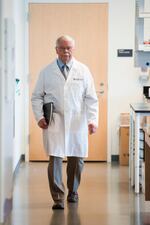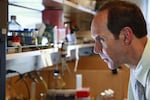Leaders at the Knight Cancer Institute know that scientific discoveries are not guaranteed, even with $1 billion to spend looking for answers.
They also know that some of the world's most dramatic discoveries happened by accident, when scientists were looking for something completely different than what they ended up finding.

How do you attract a researcher like Mike Heller who's 72, has 55 patents to his name and can afford to buy a yacht and sail off into the sunset? “It's the science," he said.
OHSU / OPB
So as Oregon Health & Science University administrators begin the quest to cure cancer, one of their first challenges is assembling a team. They're working to bring hundreds of top-class researchers together, from dozens of disciplines, to explore many, many different ideas.
But who are these scientists? And why are so many willing to wrap up the research they're doing elsewhere to make Oregon home?
Let's take one example: Mike Heller from San Diego.
Back in the 1990s Mike Heller was a professor and researcher at the University of California, San Diego. He had an idea: Maybe DNA could be used as a form of memory — for a computer.
He got some entrepreneurs interested, but they worried that Heller was a biologist and didn’t know much about computers. So they brought in engineer Sadik Esener.
The two scientists hit it off.
“I learned quite a bit from him," Esener said. "He came to teach me molecular biology every Friday afternoon. And based on that interaction, we started a company called Nanogen.”
In the end, Nanogen didn’t use DNA for computer memory. Instead, the company developed a method of using computer chips to screen blood for snippets of cancer DNA.
That kind of collaborative, multi-disciplinary work — a kind of intellectual cross-pollination that can lead to surprising results — is the goal at OHSU.
With that in mind, the institute convinced Esener to moved to Portland last summer to head up the effort to recruit researchers focused on early detection. One of the first scientists he reached out to was Heller, his old friend.

Biologist Mike Heller and engineer Sadik Esener will collaborate at the new institute to develop new ways of fighting cancer.
OHSU / OPB
“He is an incredibly good collaborator. And he’s amazing in the lab and, of course, he has a very good knowledge of the field,” Esener said.
But building a team to tackle cancer isn't as easy as calling one old friend and telling him: "Hey, we're something cool in Stumptown. Come join us."
Like many of the scientists OHSU hopes to draw, Heller has built a life and a career somewhere else, teaching and running a lab full of researchers. His friends are in San Diego and so is some of his family.
In Heller's case, OHSU had to convince someone who’s already spun several highly profitable companies off of his research work and could easily retire.
“I’m only in it because of the science," Heller said. "Yeah, I could have gone with the other side of it … but it’s the science.”
Heller says his main area of research in San Diego was coming to a natural end, and he was intrigued by the culture administrators at OHSU are trying to create at the Knight Cancer Institute.
He said he hopes it will be like the effort to reach the moon in the 1960s — where all the technology necessary to do something is actually already available and just requires the right team and a concentrated effort.
“It’s going to be people totally focused on this," Heller said. "'How are we doing this? What are other people doing?'I think that’s an advantage, a real advantage.”
He said he's excited by the chance to gather lots of different ideas then quickly test them to see if they bear fruit.
That’s different to the traditional approach taken at some research institutions, in which one team researches one specific question or medical approach for year after year. The idea of a new way of tackling cancer is appealing: Heller said a number of his students jumped at the chance to follow him.
“If they do something here, they'll be able to go anywhere they want. There will be opportunities if they’re entrepreneurial, to start new businesses," he said. "Our intention is, if someone out there doesn’t have that, or the technology doesn’t already exist, we would like to be the ones to come up with that final technology."

Brian Druker says the quality of life in Oregon is a draw for some scientists, but it’s also the chance to work on something as iconic as the cure for cancer.
OHSU / OPB
The new institute also has something to attract researchers that most other institutes around the country don’t — cold, hard cash.
It’s not unusual for scientists to spend half their time chasing money. But Brian Druker, who leads the Knight Cancer Institute, says funding here is pretty much guaranteed.
“We expect people to get some of their own grants, we expect people to be able to leverage the funding they’re given, but we have some stability," he said, "which is truly remarkable in today’s environment."
The issue of leaving family and moving to Portland can be another challenge in recruiting top scientists. In Heller’s case, he said his kids are scattered all over the country, which makes it easier to leave San Diego. Plus, he's drawn to the quality of life in Oregon.
And like all the scientists who'll be coming to Portland in the next few years, Heller has his own personal reasons for making cancer the focus of his work.
So does the man recruiting him. Sadik Esener lost two family members to the disease five years ago. They died within a month of each other.
“My experience with cancer has been very frustrating," he said.
"When we were trying to treat my wife and my mother, there was really no hope. So the only way that I can see having hope is catching the disease before it becomes too heterogenous.”
